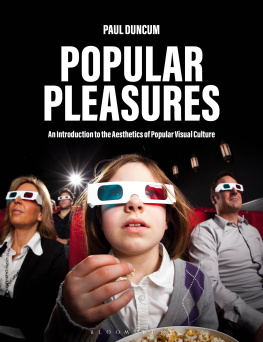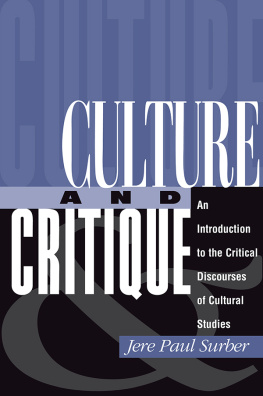
Popular
Pleasures
ALSO BY PAUL DUNCUM AND ALSO PUBLISHED BY BLOOMSBURY
Picture Pedagogy: Visual Culture Concepts to Enhance the Curriculum

Contents
Copyright Key
(a) Public Domain in its country of origin and other countries and areas where the copyright term is the authors life plus 100 years or fewer.
(b) Creative Commons Attribution-Share Alike 4.0 International.
(c) Creative Commons Attribution-Share Alike 2.0 Generic.
(d) I, the copyright holder of this work, release this work into the public domain. This applies worldwide.
(e) Creative Commons 1.0 Universal Public Domain Dedication.
(f) Creative Commons Attribution-Share Alike 3.0 Unported.
(g) This work is in the public domain in the United States because it is a work prepared by an officer or employee of the United States Government as part of that persons official duties under the terms of Title 17, Chapter 1, Section 105 of the US Code.
Chapter Outline
For modernist aesthetic theorists, the term popular aesthetics was an oxymoron. When they bothered to consider popular aesthetics at all, the word popular implied the masses and the debasement of taste, whereas aesthetics referred to a quasi-spiritual experience associated with the fine arts. Popular meant crassness, tackiness, or vulgarity; aesthetics involved refinement and good taste and spoke to noble aspirations. Fine art celebrated what was indisputably humanlove, passion, and an appreciation of beautyand it was set apart from all mundane considerations, an autonomous realm unto itself, while popular imagery was motivated by nothing but grubby monetary gain. For Immanuel Kant ([1790] 1952), who more than anyone else laid the foundations of modernist aesthetics, aesthetic experience was uncontaminated by concerns beyond itself. We were to delight in aesthetic pleasure entirely for its own sake, or as he put it, the delight which determines judgements of taste is independent of all intent (42). He advised that in order to judge in matters of taste one must preserve complete indifference (43). Objects viewed as beautiful or sublime neither relied upon nor created utilitarian interest; they simply were. While useful things please as a means to an end, things that please on their own account are good in themselves.
By contrast, in the pages that follow it is assumed that when we experience cultural sites like theme parks, shopping malls, and casinos, we experience them aesthetically. When we enter fast-food restaurants, attend football matches, drive past billboards along the highway, collect souvenirs, surf the net, watch movies, and play video games we are subject to aesthetic appeals no less than in the presence of fine art. For the most part, most people enjoy such appeals because they satisfy what Miron (2002) calls the human greed for pleasure (458).
Aesthetics commonly refers both to a particular kind of experience and a branch of philosophy dedicated to the study of that experience. This book is concerned with both; it is a study in what people commonly experience with popular imagery.
The word aesthetics is derived from the ancient Greek term aesthesis, which meant sensation or sense data. Aesthesis pertained to things perceptible by the senses, things material, as opposed to things only thinkable or immaterial (Dickie 1997). It was used to distinguish between things that could be perceived through the senses and things that could only be imagined. Aesthesis referred to both pleasant and unpleasant sensations. Its opposite was anaestheticthe lack of sensationso that to experience aesthesis simply meant being awake and aware of ones surroundings.
By contrast to the narrow, modernist focus on only uplifting, ennobling experience, it is the original, highly inclusive definition of aesthetics that informs current, popular usage, and it is this broad definition that informs this book. Aesthetics here refers to the specifically visual features of imagery as well as the psychological intensities associated with them. A range of experiences is engaged: the desires we bring to images; conscious, cognitive reflection; and sensory and emotional responsesoften as densely woven entanglements with each other. And often how we are affected need not be entirely conscious. Affects can include the ineffable, miniscule, visceral intensities that operate beneath consciousness (Anable 2018). At times, images cause us primarily to think, sometimes to feel something specific, and sometimes our responses are so subtle they defy naming. Popular aesthetics include the bodys and the embodied minds ongoing immersion in all that is going on when viewing imagery: the affective, psychological states as responses to, and desires associated with, popular culture.
Popular culture is what appeals to a broad cross section of people, produced by trained professionals on their behalf, or alternatively, imagery produced by ordinary untrained people for their own enjoyment (Williams 1976). The latter is often called vernacular culture. In this book the primary concern is with the first kind: professionally produced mass culture. Mass culture is our dominant culture, partly, because there is more of it than any other kind; partly, because its production is closely tied to the dominant economic arrangements of our society, namely consumer capitalism; and, partly, because it mostly embodies mainstream social views and values (Williams 1977). Today, most mass popular culture is produced by global corporations as a capitalist enterprise and linked closely to, and reliant upon, other capitalist enterprises. Additionally, and significantly, mass popular culture typically reproduces the widely shared beliefs and major preoccupations of a society. Mass popular culture is top-down; vernacular culture is bottom-up, although there is some convergence where one influences the other (Firestone and Clark 2018).
The specific social arrangements associated with the production of popular culture have changed over the years. Yet the basic distinction made above between an officially sanctioned culture for people and an unofficial culture of people is perennial. It is often proposed that popular culture emerged during the nineteenth century as a consequence of new, mass technologies and newly created class distinctions (Storey 2003), but the position taken here is that the lures of popular culture are of much greater long-standing. Many of the attractions to premodern fine art conform to popular preferences. This is not to equate premodern fine art with the popular culture of its dayfine art was often used to distinguish between it and the popularbut premodern fine art appears to have excited many of the same pleasures that have been popular over millennia. Often demarcations between the fine and the popular appear to be more a matter of minor distinctions than substantive differences. Popular culture is at once entirely dependent upon its specific time and place, and also to be what Gilroy (2000) calls the changing same, not an invariant essence but something that is ceaselessly reprocessed (129). Being substantially located in the body, popular lures have proven perennial.
The significance of popular imagery lies not only in the pleasures it affords, but in its power to influence and inculcate ideas of a sociopolitical nature. Making sense of our senses is important because the seemingly most innocent of aesthetic experiences have ethical and political consequences. As Ranciere (2004) claims, aesthetics is at the core of politics (13). As Walker and Chaplin (1997) argue, pleasure is a crucial ingredient of the subjective experience of visual culture but it is never innocent (1223).
Next page










